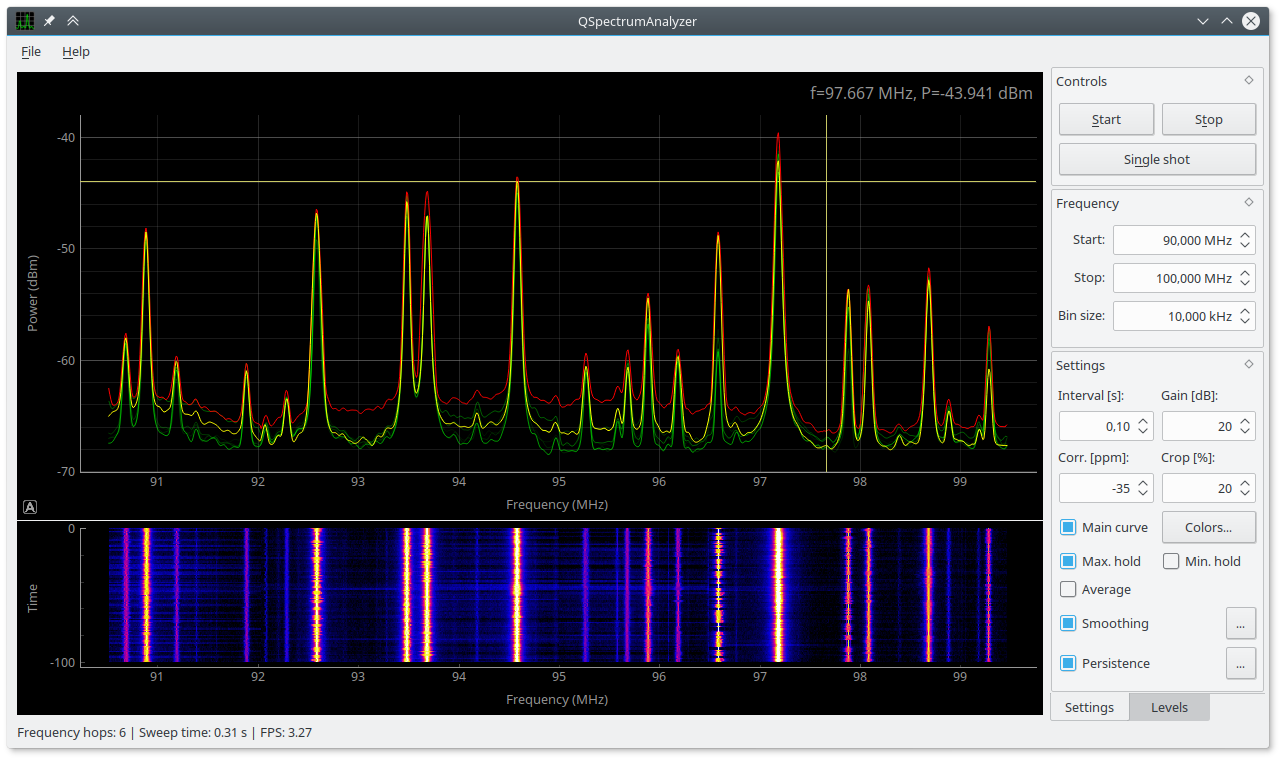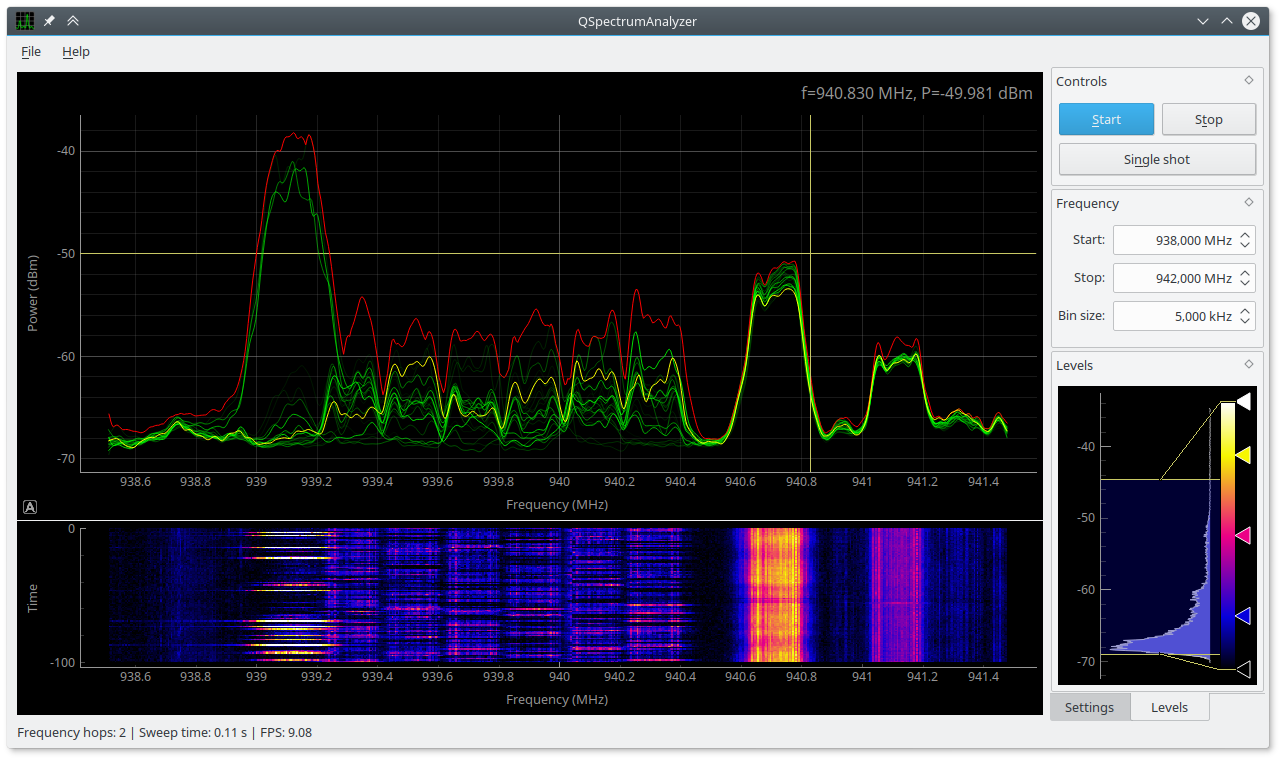QSpectrumAnalyzer
Spectrum analyzer for multiple SDR platforms (PyQtGraph based GUI for soapy_power, hackrf_sweep, rtl_power, rx_power and other backends)
Screenshots
Requirements
- Python >= 3.3
- PyQt4 / PyQt5 / PySide / PySide2
- Qt.py (https://github.com/mottosso/Qt.py)
- PyQtGraph (http://www.pyqtgraph.org)
- soapy_power (https://github.com/xmikos/soapy_power)
- Optional: hackrf / rtl-sdr / rtl_power_fftw / rx_tools
Backends
Default backend
- soapy_power (https://github.com/xmikos/soapy_power)
soapy_power is the default and recommended universal SDR backend in QSpectrumAnalyzer.
It is based on SoapySDR and supports
nearly all SDR platforms (RTL-SDR, HackRF, Airspy, SDRplay, LimeSDR, bladeRF,
USRP and some other SDR devices). It is highly configurable (see additional parameters
help in Settings menu) and supports short acquisition time for
near real-time continuous measurement.
Other backends
- hackrf_sweep (https://github.com/mossmann/hackrf)
hackrf_sweep backend enables wideband spectrum monitoring by rapidly retuning the radio
without requiring individual tuning requests from the host computer. This allows unprecedented
sweep rate of 8 GHz per second. Only HackRF is supported.
- rtl_power_fftw (https://github.com/AD-Vega/rtl-power-fftw)
rtl_power_fftw is alternative backend for RTL-SDR devices and has various
benefits over rtl_power. E.g. better FFT performance (thanks to
use of fftw library) and possibility to use short acquisition time
for near real-time continuous measurement (minimum interval in original
rtl_power is 1 second).
- rtl_power (https://github.com/keenerd/rtl-sdr)
rtl_power is original backend for RTL-SDR devices. There are better alternatives now, but
if you want to use it, you should use Keenerds fork of rtl-sdr
(latest Git revision), because rtl_power in original rtl-sdr package (from osmocom.org)
is broken (especially when used with cropping).
- rx_power (https://github.com/rxseger/rx_tools) [unsupported]
rx_power (part of rx_tools) is also based on SoapySDR (like default soapy_power backend)
and therefore supports nearly all SDR platforms. But it is much slower than soapy_power, doesn't support
near real-time continuous measurement (minimum interval is 1 second, same as rtl_power)
and is buggy. Backend is currently unsupported, if you want to fix it, patches are welcome.
Usage
Start QSpectrumAnalyzer by running qspectrumanalyzer.
You can choose which backend you want to use in File -> Settings
(or Application menu -> Preferences on Mac OS X), default is
soapy_power. Device, sample rate, bandwidth, LNB LO, path to backend executable
and additional backend parameters can be also manually specified there. You can
also set waterfall plot history size. Default is 100 lines, be aware that
really large sweeps (with a lot of bins) would require a lot of system
memory, so don't make this number too big.
Controls should be intuitive, but if you want consistent results, you should turn off automatic gain control (set gain to some fixed number) and also set crop to 20% or more. For finding out ppm correction factor for your rtl-sdr stick, use kalibrate-rtl.
You can move and zoom plot with mouse, change plot settings or export plots from right-click menu. Waterfall plot black/white levels and color lookup table can be changed in mini-histogram widget (on Levels tab).
Installation
Arch Linux:
Stable version:
git clone https://aur.archlinux.org/qspectrumanalyzer.git cd qspectrumanalyzer makepkg -sri
Git master branch:
git clone https://aur.archlinux.org/qspectrumanalyzer-git.git cd qspectrumanalyzer-git makepkg -sri
Or simply use pacaur (or any other AUR helper) which will also automatically install all QSpectrumAnalyzer dependencies:
pacaur -S qspectrumanalyzer pacaur -S qspectrumanalyzer-git
Ubuntu:
# Add SoapySDR PPA to your system sudo add-apt-repository -y ppa:myriadrf/drivers # Update list of packages sudo apt-get update # Install basic dependencies sudo apt-get install python3-pip python3-pyqt5 python3-numpy python3-scipy soapysdr python3-soapysdr # Install SoapySDR drivers for your hardware (e.g. RTL-SDR, Airspy, HackRF, LimeSDR, etc.) sudo apt-get install soapysdr-module-rtlsdr soapysdr-module-airspy soapysdr-module-hackrf soapysdr-module-lms7 # Install QSpectrumAnalyzer locally for your current user pip3 install --user qspectrumanalyzer
qspectrumanalyzer and soapy_power executables will be then placed in
~/.local/bin directory, you can add it to your PATH in ~/.bashrc.
If you want to install QSpectrumAnalyzer directly from Git master branch, you can use this procedure:
git clone https://github.com/xmikos/qspectrumanalyzer.git cd qspectrumanalyzer pip3 install --user .
Windows:
Only 64-bit Windows are supported (there are no public 32-bit builds of SoapySDR libraries and drivers).
- install SoapySDR libraries and drivers
(bundled as part of Pothos SDR installer: download).
This bundle also includes other great SDR apps like CubicSDR, GQRX,
GNU Radio Companion, Pothos GUI,
Lime Suite and Zadig.
Utilities like
hackrf_sweepandrtl_powerare also included. - download QSpectrumAnalyzer installer or portable zip archive from GitHub releases page
- after you connect your SDR device, you have to run Zadig to install USB drivers
You can also install QSpectrumAnalyzer manually from PyPI:
install Python 3.6.x (64-bit) from python.org and add Python to PATH
install SoapySDR libraries and drivers (bundled as part of Pothos SDR installer: download)
Open
cmd.exeand run:pip install PyQt5 pip install QSpectrumAnalyzer
You should then be able to run it with qspectrumanalyzer (or python -m qspectrumanalyzer
if it doesn't work for you).
Todo:
- save FFT history (allow big waterfall plot saved to file)
- automatic peak detection / highlighting
- display average noise level
- frequency markers / bookmarks with notes (even importing and exporting .csv file with predefined channels, etc.)

